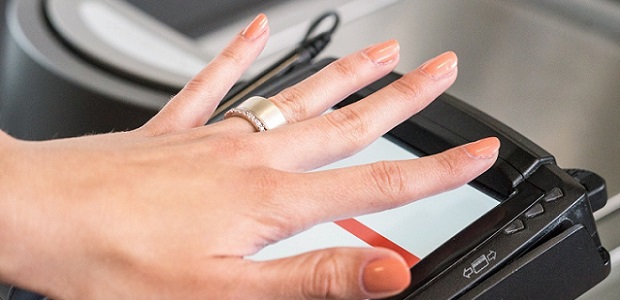
Smart rings aren’t a novel idea: there are plenty of fitness tracking, notification-sending, payment or even protective finger ornaments around. But none have the ability to identify you and authorize your transactions wherever you go. That is, until Token hits the market. It’s a biometric ring that can be used to open house doors, start cars, make credit card transactions and sign in to your computer. That all sounds nifty in theory, but without any real cooperation from the third parties that enable those authorizations, Token is all but useless. The good news is that its makers managed to get support from an impressive list of partners including MasterCard, Microsoft, Visa and HID.
That last company is responsible for 80 percent of the keyless security systems in the market, according to Token’s makers. Even if the physical readers at your office aren’t made by HID, the protocol behind them most likely is. Setting up your Token to work as an entry card is therefore as simple as getting a keycard issued, except your profile is stored on your ring instead of a physical card.
The way Token works is simple: With a fingerprint sensor on the inside, it can confirm that you’re the authorized user. Then, you slide on the ring, and an onboard IR optical sensor makes sure the device is still on your finger. As long as you have not taken it off, you can authorize transactions with a tap of your hand. Once removed, you’ll have to place your finger on the sensor again before the Token can be used for access.
You can add credit cards, login passwords and set up other profiles via a companion app, and afterwards, you won’t have to choose which transaction to authorize. The signal that is continuously broadcast (when you’re wearing the ring) can be interpreted by a variety of readers. Only one fingerprint can be assigned to each Token, as the company wants to prevent multiple users sharing such a personal product.
Token transmits the authentication signal over NFC in most situations, while Bluetooth is used when signing into existing laptops. NFC requires close proximity between devices for an authorization, so it’s not as easy as Bluetooth to exploit. But since few notebooks have NFC support yet, Token has to rely on Bluetooth for those logins, which you trigger by knocking your finger on a surface twice. When web authority W3C releases its new guidelines later this year, major browsers are expected to enable NFC or Bluetooth-based logins to websites in place of passwords. While that feature isn’t live yet, you can already sign into your laptop with Token. During my demo, the company’s owner unlocked her MacBook simply by rapping her ring-bearing hand on the table.
The Token ring is water-resistant up to 50 meters so you won’t have to remove it when washing your hands.
Tokenize estimates that Token’s battery will last up to three weeks on a charge. Each ring comes with its own wireless charging holder, and houses LED lights that will blink red each minute when your battery is down to 30 percent, which the company says is about a couple of days away from dying.
Source: www.engadget.com
Banking 4.0 – „how was the experience for you”
„To be honest I think that Sinaia, your conference, is much better then Davos.”
Many more interesting quotes in the video below: